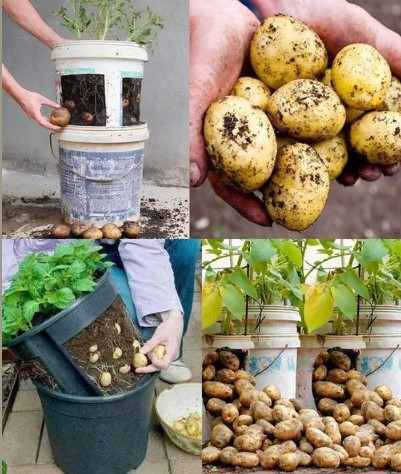How to Grow Potatoes in Old Paint Buckets
1. Prepare the Buckets:
- Clean the buckets thoroughly to remove any residue.
- Drill several drainage holes at the bottom and lower sides of each bucket to ensure proper water drainage.
2. Prepare the Potatoes:
- Chit the Seed Potatoes:
- Place the seed potatoes in a cool, light area until they sprout.
- Cutting the Potatoes:
- If using large potatoes, cut them into pieces, ensuring each piece has at least one eye or sprout.
- Allow the cut pieces to dry for a day to prevent rot.
3. Plant the Potatoes:
- Fill the bottom of each bucket with 4-6 inches of potting soil.
- Place 2-3 seed potatoes or pieces in each bucket, with the eyes facing up.
- Cover the potatoes with another 4-6 inches of soil.
4. Water and Care:
- Watering:
- Water the soil thoroughly after planting.
- Keep the soil consistently moist but not waterlogged.
- Adding Soil:
- As the potato plants grow, keep adding soil to cover the stems, leaving the top leaves exposed.
- Sunlight:
- Place the buckets in a sunny spot where they can receive 6-8 hours of sunlight daily.
5. Mulch (Optional):
- Add a layer of straw or mulch on top of the soil to help retain moisture and control weeds.
6. Harvesting:
- For Baby Potatoes:
- Harvest 2-3 weeks after the plants flower by carefully digging around the plants.
- For Mature Potatoes:
- Wait until the foliage turns yellow and dies back.
- Dump the bucket to harvest the potatoes.
Tips for Success:
- Choose early or mid-season potato varieties for better results.
- Regularly check the plants for pests and take appropriate measures if necessary.
- Use a balanced, slow-release fertilizer to provide the necessary nutrients.
By following these steps, you can successfully grow potatoes in old paint buckets, making use of available materials and space efficiently. Happy gardening!
- Paula Deen’s 5-Minute Fudge (Classic Southern Style)
 C’est This old-fashioned fudge is a Southern favorite because it’s fast, foolproof, and ultra-creamy. No candy thermometer, no complicated steps—just smooth chocolate goodness loaded with crunchy pecans. Ingredients Instructions (Ready in Minutes!) Prepare the Pan Heat the Base Melt the Chocolate Add the Good Stuff Set the Fudge Slice & Serve Time & Yield Flavor … Read more
C’est This old-fashioned fudge is a Southern favorite because it’s fast, foolproof, and ultra-creamy. No candy thermometer, no complicated steps—just smooth chocolate goodness loaded with crunchy pecans. Ingredients Instructions (Ready in Minutes!) Prepare the Pan Heat the Base Melt the Chocolate Add the Good Stuff Set the Fudge Slice & Serve Time & Yield Flavor … Read more - Pecan Sandies (Classic Butter Pecan Cookies)
 This recipe has been my top pick this month—I’ve made it six times, and it’s still just as magical every single batch. Pecan Sandies are a timeless cookie, celebrated for their tender, crumbly texture and deep buttery flavor. Each bite melts in your mouth, releasing the warmth of toasted pecans and vanilla. Simple in appearance … Read more
This recipe has been my top pick this month—I’ve made it six times, and it’s still just as magical every single batch. Pecan Sandies are a timeless cookie, celebrated for their tender, crumbly texture and deep buttery flavor. Each bite melts in your mouth, releasing the warmth of toasted pecans and vanilla. Simple in appearance … Read more - Chocolate Caramel Peanut Bars Homemade Candy Bars
 Introduction These chocolate caramel peanut bars are a classic homemade candy that tastes just like your favorite chocolate bar—but fresher, richer, and made with love. Layers of crunchy peanuts, soft caramel, and smooth chocolate come together to create a perfect bite. They’re ideal for holidays, parties, gifting, or whenever you want a decadent treat that … Read more
Introduction These chocolate caramel peanut bars are a classic homemade candy that tastes just like your favorite chocolate bar—but fresher, richer, and made with love. Layers of crunchy peanuts, soft caramel, and smooth chocolate come together to create a perfect bite. They’re ideal for holidays, parties, gifting, or whenever you want a decadent treat that … Read more - Creamy Cheesy Broccoli Vegetable Casserole
 Introduction This creamy broccoli vegetable casserole is a warm, comforting dish packed with vibrant vegetables and smothered in a rich, cheesy sauce. It’s perfect for family dinners, holidays, potlucks, or when you want a hearty meatless meal. The combination of broccoli, cherry tomatoes, bell peppers, and melted cheese creates a dish that’s both nutritious and … Read more
Introduction This creamy broccoli vegetable casserole is a warm, comforting dish packed with vibrant vegetables and smothered in a rich, cheesy sauce. It’s perfect for family dinners, holidays, potlucks, or when you want a hearty meatless meal. The combination of broccoli, cherry tomatoes, bell peppers, and melted cheese creates a dish that’s both nutritious and … Read more - What Your Favorite Cake Reveals About Your Personality (and Why “Difficult” Might Just Mean Delightfully Unique)
 Food has a funny way of telling stories about who we are. From your morning coffee order to your favorite snack, what you reach for often reflects your mood, personality, and even your values. But have you ever wondered what your favorite cake might say about you? Food has a funny way of telling stories … Read more
Food has a funny way of telling stories about who we are. From your morning coffee order to your favorite snack, what you reach for often reflects your mood, personality, and even your values. But have you ever wondered what your favorite cake might say about you? Food has a funny way of telling stories … Read more
